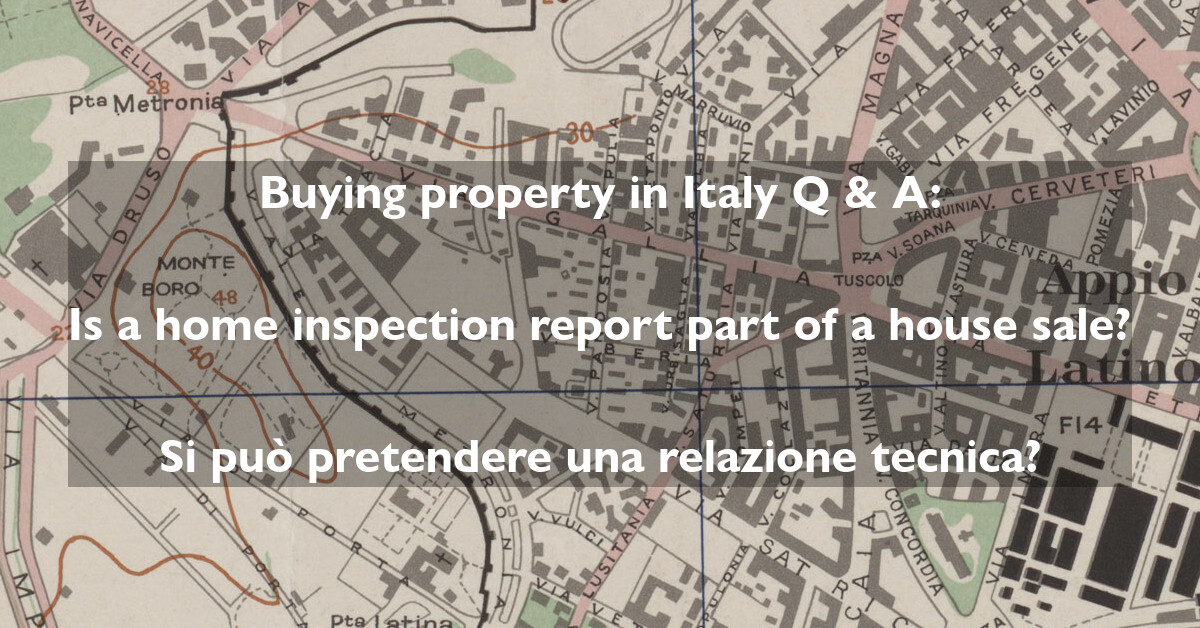Is a home inspection report part of the sale process?

There are a series of requirements which a seller must fulfill; these are documented (but not verified) by the notaio.
By law the seller is responsible for ensuring the property has a building permit and planning permission for subsequent changes where required (by obtaining, where necessary, and citing the pertinent documents in the transfer agreement or in some cases swearing to this effect) and is responsible for the correctness of the land registry (catasto) data used for tax purposes. This is often referred to as the conformità catastale, urbanistica ed edilizia.
The name of a building permit, required nationally for buildings built since 1942, has changed over time:
- Licenza edilizia: for buildings built between 17-10-1942 and 30-01-1977 ("Legge Urbanistica", 17 agosto 1942, n. 1150)
- Concessione edilizia: for buildings built between 30-01-1977 and 30-06-2003 (Legge 28 gennaio 1977 n. 10)
- Permesso di costruire: for buildings built after 30-06-2003 (Testo Unico DPR 380/01)
Buildings built before the requirement of a Licenza edilizia are generally exempt from the building permit requirement. It is also possible to self-certify that a building built before September 1967 has a permit, but it is best to find the permit.
Changes requiring planning permission (building change permits) must also be documented.
Some work may have been done illegally and then regularized as part of amnesties in 1985, 1994 and 2003. This must be documented.
The owner thus should be in possession of permits which correspond to the current state of affairs. They are obtained from the local city or town "technical" office.
Habitability Certificate. Once a building is completed, a habitability certificate (agibilità) should be issued. This is not strictly necessary for a sale, but highly recommended.
The seller must also provide an energy rating certificate, "Attestato di Prestazione Energetica (APE)".
In some areas, particularly parts of Emilia Romagna and Tuscany, a notaio will ask for a technical report (by a geometra, architect or other qualified individual) documenting the conformità edilizia & urbanistica. This is an excellent idea to protect both buyer and seller (the seller has legal responsibility) and is normally paid for by the seller with some exceptions. The report is not required by law, despite what the notaio might imply. There was a recent competition authority ruling that says explicitly a notaio cannot require a report from a technician.
A buyer may choose to hire their own professional to review the building permits and situation on the ground, even if the seller provides a report: trust but verify.
Certification of systems (impianti a norma): systems built/installed after 13 March 1990 must meet or exceed standards in force at the time of installation. This includes things like the electric, the heating, cooling and plumbing systems. In lieu of certificates, a seller may declare a system does not meet standards and the onus to bring the system(s) up to standard will fall to the buyer. This is pretty common, especially for homes that haven't been updated in years.
A buyer is welcome to commission a professional for an inspection for potential hazards, which depending on the property might include lead paint, dampness, asbestos or radon. This type of inspection is rather rare in Italy.
Naturally you'll want to know a home's situation before making an offer, or you'll want to potentially make your offer conditional on the above requirements.
❖ ❖ ❖
The above is offered as general guidance without warranty; changes may have occurred since it was written. Do consult with appropriate qualified professionals regarding your specific situation before making any real estate purchase.
About the author

Sean Michael Carlos grew up in Rhode Island, USA. He studied in the US, UK and Germany before settling in Italy where he has lived for over twenty-five years, in three different regions.
Sean is a licensed real estate agent in Italy with over 10 years experience in the sector and would love to hear from you if you are looking to buy or sell property in Italy.





































